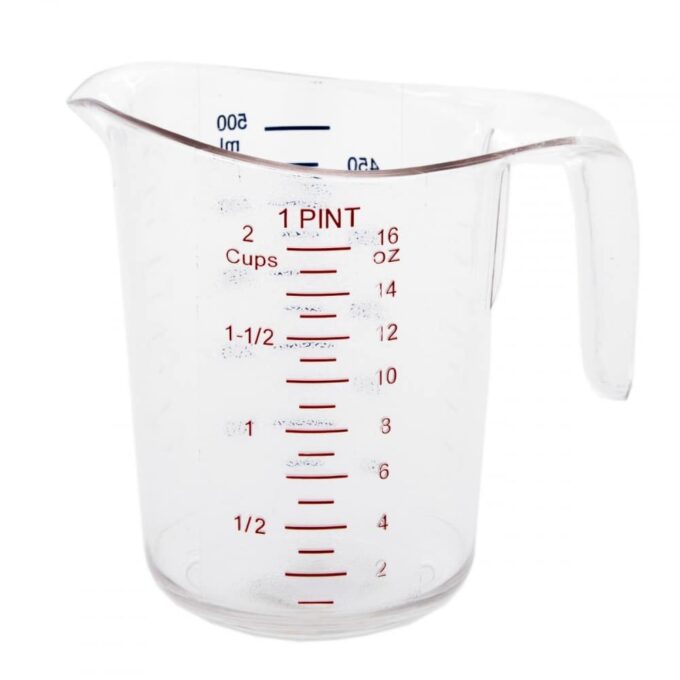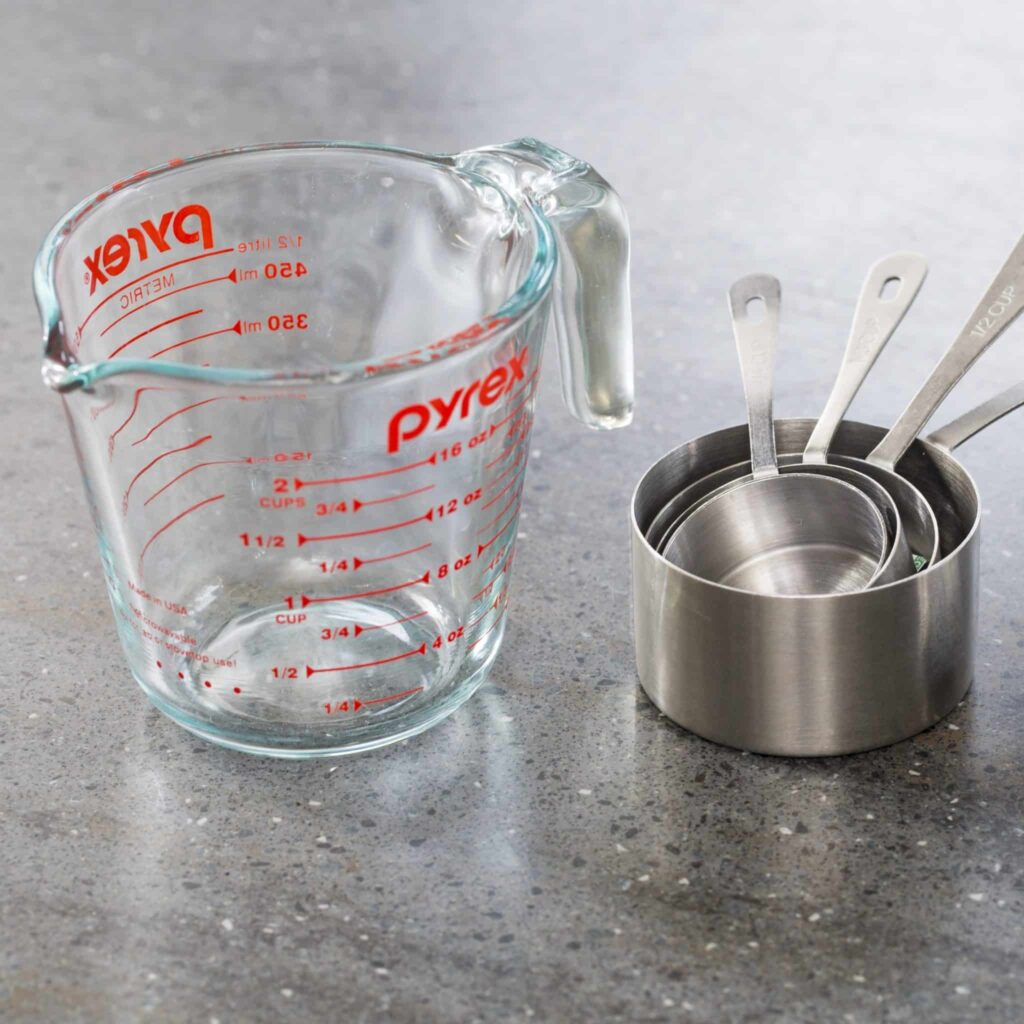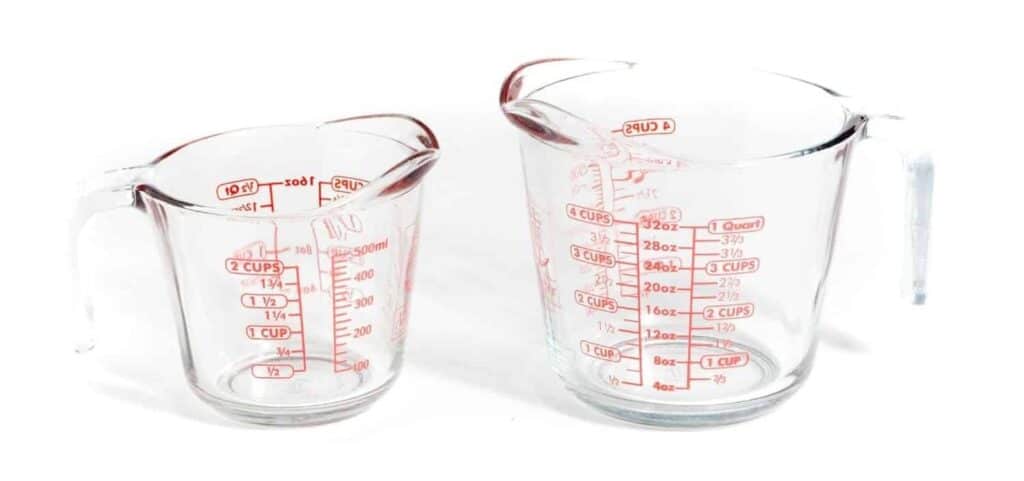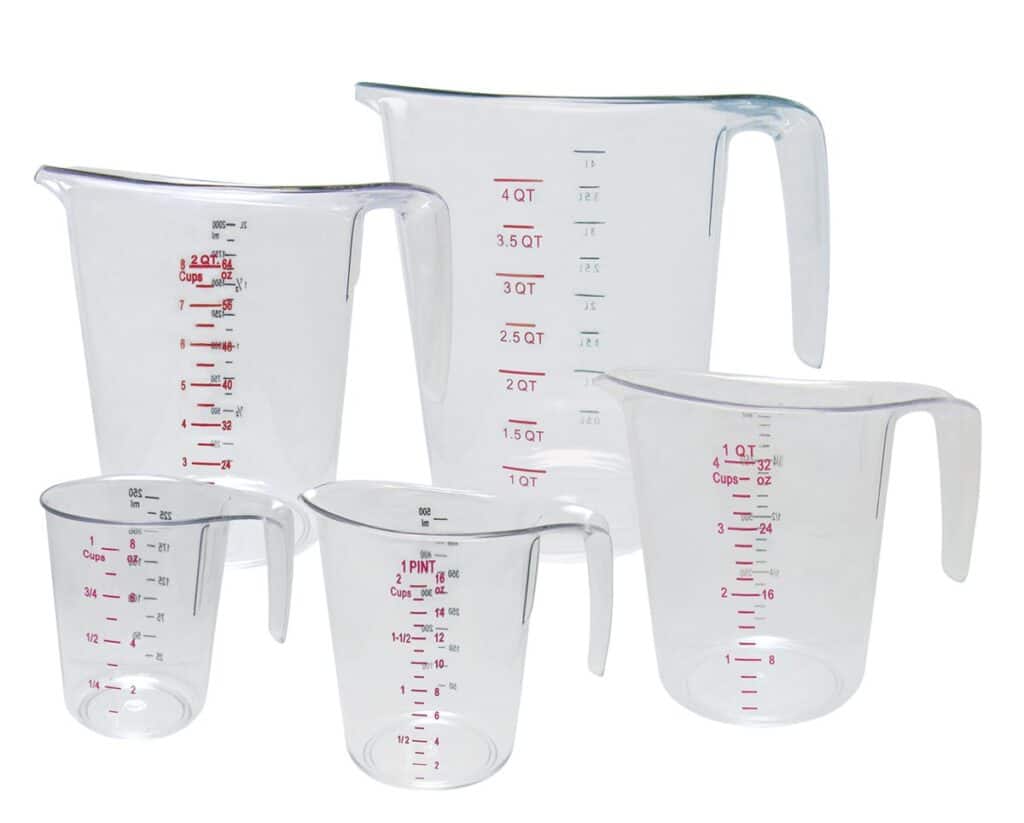How many cups in a pint? This simple yet crucial question often arises in the world of culinary measurements. Whether you’re an experienced cook, a budding baker, or simply someone curious about kitchen measurements, understanding the relationship between cups and pints is essential.
This article will delve into the topic, demystifying the cup-to-pint conversion and shedding light on the precise measurements that ensure recipe accuracy. Join us as we explore the ins and outs of this fundamental culinary conversion and discover the answer to the ever-present question: how many cups are in a pint?
Get ready to unravel the mysteries of volume measurements and gain confidence in your kitchen endeavours.

SEE ALSO:
What Is A Cup?
A cup is a unit of volume measurement in the United States. The cup is used in dry and liquid measurements for cooking and baking recipes. It is also used for measuring individual servings of food, such as cereal or ice cream. One cup equals 8 fluid ounces, 16 tablespoons, ¼ quart, or about 237 millilitres. The abbreviation for a cup is c.
SEE ALSO: How many Quarts in a Gallon (Food Measurements)
What Is A Pint?
A pint is 16 fluid ounces or two cups. A pint in the United States also measures volume. Pints are often used when measuring liquid ingredients for recipes. A pint equals 16 fluid ounces, 32 tablespoons, ½ quart, or about 473 millilitres. This differs from a British imperial pint, which is 20 fluid ounces.
The abbreviation for a pint is pt.s. The term “pint” comes from the French word pinte and likely from the Latin term pincta, derived from painted marks on the side of a container to show its capacity. In Rome, a pint was 1/8 of a gallon, as eights were a normal unit of measurement.
SEE ALSO: How Many Pints are in a Gallon? (Gallon to Pint Conversion)
Cups Vs. Pints
A cup and a pint are common units of measure that can be confusing. But both cups and pints are measures of volume in the United States.
When deciding between using cups or pints for your baking or cooking needs, consider what you’re making, the quantity of the ingredients, and how accurate you need the measurements.
Cups are often used for baking recipes because they allow you to measure precise amounts more easily. If precision isn’t important, then using either unit should work fine. But if more accuracy matters, using cups may be the better option. And if you have larger quantities, it will be easier to use pints.

How Many Cups In A Pint?
One pint is equal to 2 cups. So there are 2 cups in a pint. This means that for every pint, you will get 2 cups. Two cups equal 1 pint, and 4 cups equal 2 pints or 1 quart.
1 pint = 2 cups
- There are 2 cups in 1 pint.
- There are 4 cups in 2 pints.
- There are 8 cups in 4 pints.
- There are 10 cups in 5 pints.
- There is 1 cup in half a pint.
SEE ALSO: How Many Cups in a Gallon? Your Ultimate Conversion Guide
Converting Between Cups and Pints
The conversion factor between cups and pints is 2 cups per pint. You can convert from cups to pints or cups by multiplying or dividing by 2.
Pints to Cups: How many cups are in a Pint
To convert pints to cups, multiply the number of pints by 2.
Number of cups = Number of pints × 2
For example, if you want to know how many cups are in 4 pints, multiply 2 by 4.
Number of cups = Number of pints × 2
Number of cups = 4 × 2
Number of cups = 8
So, there are 8 cups in 4 pints.
SEE ALSO: How many Tablespoons in a Cup (convert tbsp to cup)
Cups To Pints: How many Cups in a Pint
To convert cups to pints, divide the number of pints by 2.
Number of pints = Number of cups ÷ 2
For example, if you want to know how many pints are in 12 cups, you divide 12 by 2.
Number of pints = Number of cups ÷ 2
Number of pints = 12 ÷ 2
Number of pints = 6
So, there are 6 pints in 12 cups.

Cups, pints, quarts, gallons, and ounces chart
If you wonder about cups to pints to quarts to gallons and ounces conversions, here is another handy chart.
| Cups | Pints | Quarts | Gallons | Ounces |
| ½c | ¼ pt | ⅛qt | 1/32gal | 4oz |
| 1c | ½pt | ¼qt | 1/16gal | 8oz |
| 2c | 1pt | ½qt | ⅛gal | 16oz |
| 4c | 2pt | 1qt | ¼gal | 32oz |
| 8c | 4pt | 2qt | ½ gal | 64oz |
| 12c | 6pt | 3qt | ¾ gal | 96oz |
| 16c | 8pt | 4qt | 1gal | 128oz |
Memorizing some common kitchen conversions is easy and fun. Just remember that in the U.S. measurement system
- 1 gallon = 4 quarts, 8 pints, or 16 cups
- 1 quart = 2 pints or 4 cups
- 1 pint = 2 cups
SEE ALSO: “How Many ML in a Cup? Your Essential Guide to Accurate Measurements
Measuring liquid ingredients
Liquid measuring cups measure liquid ingredients like olive oil, milk, and broth. To measure liquid ingredients, place your liquid measuring cup on a flat surface and pour the liquid even with the measuring line.
Liquid Measurement Chart
It’s helpful to know some simple kitchen conversions when you need to adjust a recipe, whether it’s to double it or cut the amount in half. Knowing these simple conversions will help you adjust measurements in a recipe to achieve the desired results.
Quick Conversions
| Ounces | Cups | Pints | Quarts | Gallons |
| 8 fl oz | 1 cup | 1/2 pint | 1/4 quart | 1/16 gallon |
| 16 fl oz | 2 cups | 1 pint | 1/2 quart | 1/8 gallon |
| 32 fl oz | 4 cups | 2 pints | 1 quart | 1/4 gallon |

SEE ALSO: How Many Ounces in a Cup (Food Measurements)
Measuring Liquid Ingredients Vs. Dry Ingredients
When baking, measurements are important in how well the final product comes out. Learning how to precisely measure ingredients ensures that no mishaps or mistakes, like the recipe being too moist, too dry, or not rising properly, happen along the way.
You have probably noticed that there are many different styles of measuring cups on the market, from big plastic or glass containers with handles on the sides and markings of measurements to
hand-held plastic or metal measuring cups that only measure out one specific size.
But have you ever noticed that when it comes to the single-measurement cups that are often used, there are actually two different kinds? The difference in these measuring cups depends on whether you are measuring out liquid ingredients or dry ingredients.
Measuring cups meant for liquids have little pouring spouts on the sides that make it easier to transfer the measured liquid to the larger container. They are also there to ensure that you don’t overfill the cup.
In contrast, measuring cups for dry ingredients have a soft brim and flat top. Generally, to properly measure dry ingredients, take a butter knife and slide it across the top so that a clean, even amount of dry ingredients remain.
However, certain dry ingredients have special rules. Items like brown sugar are notorious for being packed tightly into the measuring cup, unlike flour, which should not be tightly packed because the recipe will be too dry.
To properly measure flour and powders, take a smaller spoon and scoop it into the measuring cup until there is enough to fill it. Use the butter knife technique to then make an even amount. This is the ‘scooped and leveled’ seen in the instructions!
For other items, such as rice, oats, or granulated sugars, fill the measuring cup until it is full, shimmying and shaking it until just right. For liquid ingredients, either use an exact measuring cup that has a spout (for example, a cup that only holds ¼ cup) or a larger measuring cup with varying amounts.
For the latter, set the measuring cup on a flat, level surface, and slowly pour out the liquid ingredient until it reaches the desired amount. To best do this, bend down so that you are at eye level with the measuring cup, which gives the most precise measurement.
SEE ALSO: How Many Square Feet in an Acre: How to Calculate the Size
Imperial (US) System vs Metric System
Different countries use different volume and weight measurements. Some countries use the Imperial System, while some use the Metric System.
The United States still uses the Imperial System for measurements (developed and used in the United Kingdom around 1826). In contrast, most countries like the United Kingdom, Australia, and Canada have since adopted the metric system using measurements like grams, meters, litres, kilograms, and kilometers.
There aren’t significant differences in volume between the Imperial (US) and Metric measuring systems.
For the most part, the Metric System has replaced the imperial system in countries that once used it. The United States is one of the few countries worldwide that has yet to switch to the Metric System of measurement.
But if you’re in a pinch, if a recipe is written using the Metric system, you can easily use US teaspoons and tablespoons to convert to metric measurements.
Converting US Standard to Metric System [Approximate Measurements]
- 2 cups = 1 pint = 16 fluid ounces = 32 tablespoons = 474 mL
- 1 cup = 1/2 pint = 8 fluid ounces = 16 tablespoons = 237 mL
- 1/2 cup = 1/4 pint = 4 fluid ounces = 8 tablespoons = 118 mL
SEE: Oven Temperature Conversion C to F
How many cups are in a gallon
| Gallons | Cups |
| 1 US fluid gallon | 16 US cups |
| 1 US dry gallon | 18.6 US cups |
| 1 Imperial gallon | 18.18 metric cups |
| 1 gallon of water | 16 cups |
| 1 gallon of milk | 16 cups |
| 1 gallon of coffee | 20 cups of coffee beans |
| ½ gallon of water | 8 cups |
| ½ gallon of milk | 8 cups |
| ½ gallon of coffee | 8 cups |
How many pints are in a gallon
| Gallon (gal) | Pint (pt) |
| 3 gal | 24 pt |
| 2 gal | 16 pt |
| 1 gal | 8 pt |
| 1/2 gal | 4 pt |
| 1/4 gal | 2 pt |
| 1/8 gal | 1 pt |
How many ounces are in a pint
A dry pint is 16 ounces, while a liquid pint is 20 ounces
Dry Ounces
- 20 oz = 1.07 pints
- 1 oz = .05 pints
- 10 oz = .53 pints
- 50 oz = 2.68 pints
SEE ALSO: How Much Horsepower Does a Horse Have?
Conclusion
Understanding the relationship between cups and pints is a valuable skill in the culinary world. We have explored the answer to the question “How many cups in a pint?” and discovered that in the United States customary system, there are 2 cups in a pint. This knowledge is crucial for accurate measurements when following recipes or scaling ingredients.
Recognizing the cup-to-pint conversion allows us to confidently navigate kitchen measurements and ensure recipe success. Whether adjusting quantities, converting measurements, or simply understanding the volume of ingredients, having a solid grasp of cups and pints empowers you to achieve precise and consistent results.
It is important to note that cup-to-pint ratios vary in different countries or regions. Awareness of these variations is particularly relevant when working with international recipes or encountering different measurement systems.
Understanding this fundamental relationship enhances your cooking and baking skills, bringing accuracy and precision to your kitchen adventures.
So, the next time you come across a recipe that calls for pints or cups, you can confidently convert between the two, ensuring the perfect balance of flavours and achieving culinary excellence. Embrace the knowledge of how many cups are in a pint and let it serve as a valuable tool in your culinary journey.
Related: Easy Homemade Ice Cream Recipe: Indulge in Delight
FAQs on How Many Cups in a Pint
How many pints are in a quart?
2 pints in 1 quart
1 pint is 1/2 quart.
1 pint is 16 fluid ounces, and 1 quart is 32 fluid ounces.
1 pint is 2 cups, and 1 quart is 4 cups
How many cups are in a quart?
1 gallon = 4 quarts, 8 pints, 16 cups
1 quart = 2 pints, 4 cups
1 pint = 2 cups
How many cups are in a gallon?
Gallons
Cups
1 US fluid gallon
16 US cups
1 US dry gallon
18.6 US cups
1 Imperial gallon
18.18 metric cups
1 gallon of water
16 cups
1 gallon of milk
16 cups
1 gallon of coffee
20 cups of coffee beans
½ gallon of water
8 cups
½ gallon of milk
8 cups
½ gallon of coffee
8 cups
How many pints are in a gallon?
Gallon (gal)
Pint (pt)
3 gal
24 pt
2 gal
16 pt
1 gal
8 pt
1/2 gal
4 pt
1/4 gal
2 pt
1/8 gal
1 pt
How many ounces are in a pint?
A dry pint is 16 ounces, while a liquid pint is 20 ounces
Dry Ounces
1 oz = .05 pints
10 oz = .53 pints
20 oz = 1.07 pints
50 oz = 2.68 pints
